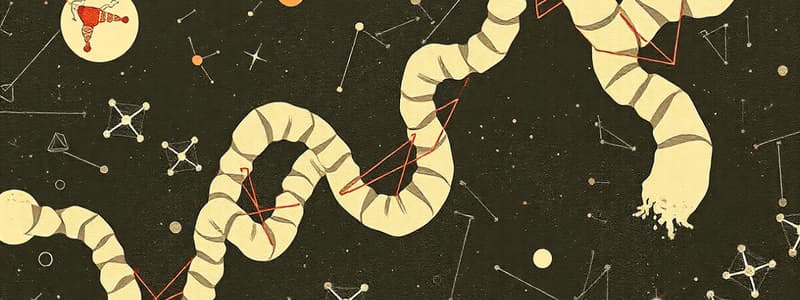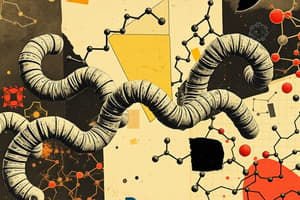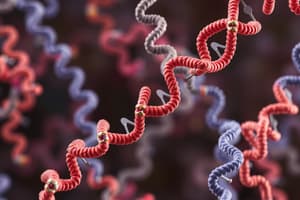Podcast
Questions and Answers
What is the fundamental structural element that distinguishes proteins from other organic compounds, according to the text?
What is the fundamental structural element that distinguishes proteins from other organic compounds, according to the text?
- A carboxyl group.
- A carbon chain.
- A hydroxyl group
- The presence of nitrogen. (correct)
Which of the following best explains the term 'essential amino acid'?
Which of the following best explains the term 'essential amino acid'?
- An amino acid the body can synthesize from other substrates.
- An amino acid that only becomes important in times of stress.
- An amino acid the body can only obtain from dietary sources. (correct)
- An amino acid that is required for basic metabolic functioning.
What role do heat, alcohol, acids and salts of heavy metals play in protein structure?
What role do heat, alcohol, acids and salts of heavy metals play in protein structure?
- They cause denaturation by disrupting the normal protein chain. (correct)
- They help form peptide bonds.
- They maintain the precise sequence of amino acids.
- They participate in protein syntheses
During digestion, which enzyme initiates the breakdown of large polypeptides in the stomach?
During digestion, which enzyme initiates the breakdown of large polypeptides in the stomach?
What is the primary function of the liver in protein metabolism according to the information?
What is the primary function of the liver in protein metabolism according to the information?
Which of the following BEST describes the concept of 'complementary proteins'?
Which of the following BEST describes the concept of 'complementary proteins'?
According to the provided data, which food has the highest NPU (Net Protein Utilization) value?
According to the provided data, which food has the highest NPU (Net Protein Utilization) value?
A lacto-ovo vegetarian's diet is MOST likely to include which of the following?
A lacto-ovo vegetarian's diet is MOST likely to include which of the following?
Which of the following is NOT typically a health benefit associated with vegetarianism, according to the provided information?
Which of the following is NOT typically a health benefit associated with vegetarianism, according to the provided information?
Which of these is a potential concern specifically for vegan individuals, as compared to lacto-ovo vegetarians, according to the provided material?
Which of these is a potential concern specifically for vegan individuals, as compared to lacto-ovo vegetarians, according to the provided material?
What percentage of resting energy expenditure (REE) is typically attributed to protein metabolism?
What percentage of resting energy expenditure (REE) is typically attributed to protein metabolism?
Which of the following is NOT a primary function of proteins in the human body?
Which of the following is NOT a primary function of proteins in the human body?
In the context of immune response, what is the role of antibodies?
In the context of immune response, what is the role of antibodies?
How do proteins contribute to maintaining fluid balance within the body?
How do proteins contribute to maintaining fluid balance within the body?
What role do proteins play in maintaining acid-base balance in the blood?
What role do proteins play in maintaining acid-base balance in the blood?
Which of the following best describes how transport proteins function in the body?
Which of the following best describes how transport proteins function in the body?
What is the function of ferritin within the body?
What is the function of ferritin within the body?
Which protein is responsible for carrying oxygen in the bloodstream?
Which protein is responsible for carrying oxygen in the bloodstream?
What is the primary function of fibrin in blood clotting?
What is the primary function of fibrin in blood clotting?
During the process of deamination, what is the immediate fate of the stripped nitrogen?
During the process of deamination, what is the immediate fate of the stripped nitrogen?
Which of the following statements best describes the body's response to excess protein intake?
Which of the following statements best describes the body's response to excess protein intake?
A sedentary adult requires a daily protein intake of 0.8 grams per kilogram of body weight. What would the approximate daily protein need for an 80kg individual?
A sedentary adult requires a daily protein intake of 0.8 grams per kilogram of body weight. What would the approximate daily protein need for an 80kg individual?
An endurance athlete requires approximately 2 grams of protein per kilogram of body weight per day. Why does an endurance athlete require more protein than a sedentary adult?
An endurance athlete requires approximately 2 grams of protein per kilogram of body weight per day. Why does an endurance athlete require more protein than a sedentary adult?
Which of the following signs is NOT associated with Kwashiorkor?
Which of the following signs is NOT associated with Kwashiorkor?
A patient presents with low adipose tissue, significant weight loss, and no edema. Which form of protein-calorie malnutrition is most likely?
A patient presents with low adipose tissue, significant weight loss, and no edema. Which form of protein-calorie malnutrition is most likely?
Which is the most appropriate nutritional course of action for an individual that presents with edema caused by Kwashiorkor?
Which is the most appropriate nutritional course of action for an individual that presents with edema caused by Kwashiorkor?
A patient has a nitrogen balance of -6.4 grams. Which of the following is the most accurate interpration of the result?
A patient has a nitrogen balance of -6.4 grams. Which of the following is the most accurate interpration of the result?
Given a protein intake of 75 grams per day and a urinary urea nitrogen (UUN) output of 6 grams per day, what is the nitrogen balance of the patient?
Given a protein intake of 75 grams per day and a urinary urea nitrogen (UUN) output of 6 grams per day, what is the nitrogen balance of the patient?
Flashcards
Net Protein Utilization (NPU)
Net Protein Utilization (NPU)
The amount of dietary protein that is actually used by the body for growth and repair. It's calculated by comparing the nitrogen intake to the nitrogen excreted.
Biological Value (BV)
Biological Value (BV)
The amount of nitrogen retained in the body following the consumption of a specific protein source, compared to the amount of nitrogen retained from a reference protein (usually egg).
Limiting Amino Acid
Limiting Amino Acid
Essential amino acid that limits the amount of protein a food can contribute to growth and repair. It's the amino acid that is the most scarce or unavailable in the protein source.
Complete Protein
Complete Protein
Signup and view all the flashcards
Complementary Proteins
Complementary Proteins
Signup and view all the flashcards
Amino Acids
Amino Acids
Signup and view all the flashcards
Protein Digestion
Protein Digestion
Signup and view all the flashcards
Protein Denaturation
Protein Denaturation
Signup and view all the flashcards
Peptide Bond
Peptide Bond
Signup and view all the flashcards
Amino Acid Sequence
Amino Acid Sequence
Signup and view all the flashcards
Protein Turnover
Protein Turnover
Signup and view all the flashcards
Growth and Maintenance
Growth and Maintenance
Signup and view all the flashcards
Enzymes
Enzymes
Signup and view all the flashcards
Antibodies: The Body's Defense Force
Antibodies: The Body's Defense Force
Signup and view all the flashcards
Fluid Balance
Fluid Balance
Signup and view all the flashcards
Acid-Base Balance
Acid-Base Balance
Signup and view all the flashcards
Transport Proteins
Transport Proteins
Signup and view all the flashcards
Edema
Edema
Signup and view all the flashcards
Deamination
Deamination
Signup and view all the flashcards
Urea formation
Urea formation
Signup and view all the flashcards
Positive Nitrogen Balance
Positive Nitrogen Balance
Signup and view all the flashcards
Negative Nitrogen Balance
Negative Nitrogen Balance
Signup and view all the flashcards
Nitrogen Equilibrium
Nitrogen Equilibrium
Signup and view all the flashcards
Kwashiorkor
Kwashiorkor
Signup and view all the flashcards
Marasmus
Marasmus
Signup and view all the flashcards
Protein-Energy Malnutrition (PEM)
Protein-Energy Malnutrition (PEM)
Signup and view all the flashcards
Protein Repletion
Protein Repletion
Signup and view all the flashcards
Lipoproteins
Lipoproteins
Signup and view all the flashcards
Study Notes
Proteins
- Proteins are organic compounds composed of acid and amino groups, with a variable side group.
- Nitrogen is a key component of proteins.
- Amino acids are the building blocks of proteins.
Amino Acid Structure
- Amino acids have an amino group, an acid group, and a variable side group.
- The side group differentiates the 20 different amino acids.
Amino Acid Examples
- Glycine, Alanine, Aspartic acid, and Phenylalanine are examples of amino acids.
- Diagrams of their structures were shown.
Amino Acids
- The 20 amino acids are the basic building blocks of proteins.
- 9 are essential (indispensable); the body cannot produce them.
- 11 are non-essential (dispensable); the body can synthesize them.
Condensation
- Amino acids link together via peptide bonds.
- A peptide bond forms when water is removed.
- This process builds dipeptides, tripeptides, oligopeptides, and polypeptides.
Amino Acids - Sequencing
- The specific order of amino acids is crucial.
- Errors in sequencing can cause genetic disorders like sickle cell disease.
- In sickle cell disease, valine substitutes for glutamic acid at the 6th position.
Amino Acids - Denaturation
- Denaturation is the process of altering the protein's structure.
- It can be irreversible.
- Heat, alcohol, acids, salts of heavy metals can denature proteins.
Digestion/Absorption
- Protein digestion begins in the stomach with HCl and pepsin.
- Pepsin breaks down polypeptides into smaller units.
- In the small intestine, proteases and peptidases break down peptides into free amino acids.
Digestion - Small Intestine
- Intestinal proteases and pancreatic proteases break down polypeptides into tripeptides, dipeptides, and oligopeptides.
- Intestinal peptidases further break down these smaller peptides into amino acids.
- Amino acids cross the intestinal villi and enter the bloodstream.
Transport of Amino Acids
- Amino acids are transported by diffusion.
- The liver monitors protein synthesis, releases free amino acids into the bloodstream, and controls catabolism.
Functions of Protein
- Proteins are essential for growth, maintenance, enzymes, hormones, antibodies.
- Proteins fulfill numerous roles like maintaining fluid and electrolyte balance, and acid-base balance in the body.
Growth, Maintenance
- Proteins are crucial for cell manufacture, repair (e.g., collagen), and replacement.
- Protein turnover is the continuous synthesis and degradation of proteins.
Enzymes - Catalysts
- Enzymes are proteins that act as catalysts.
- They facilitate reactions, by forming a complex with reactants.
- The enzyme remains unchanged during the reaction.
Antibodies
- Antibodies are proteins produced by the immune system to combat invaders.
- Antigens are invaders like bacteria, toxins, viruses, and allergens.
- Antibodies are made with amino acids.
- Adequate protein promotes antibody production.
Fluid Balance
- Proteins, transported as amino acids, are essential for maintaining fluid balance.
- Proteins in blood draw water back into the bloodstream.
- Insufficient protein can cause fluid build-up (edema) in tissues.
Fluid Balance - Details
- Blood pressure forces fluid into tissue spaces.
- Proteins draw water back into the bloodstream as pressure declines.
- Without sufficient protein, fluid accumulates in tissues (edema).
Acid-base Balance
- Proteins act as buffers, maintaining a healthy blood pH (7.35-7.45).
- Acidosis (low pH) is when the body has too much acid.
- Alkalosis (high pH) is when the body has too much base.
- Proteins accept or release hydrogen ions (H+) to maintain equilibrium.
Transport Proteins
- Proteins specifically carry compounds (e.g., vitamins, minerals, oxygen, lipids).
- They maintain equilibrium of compounds in and out of cells.
- Examples include ferritin (iron storage), transferrin (iron transport), hemoglobin (oxygen transport), and lipoproteins (lipid transport).
Blood Clotting
- Fibrin is a stringy protein made during tissue injury that forms a clot to plug leaks.
- Vitamin K and calcium are needed for clotting.
Protein for Energy
- When energy needs are high, proteins may be used as an energy source, after deamination to remove the nitrogen.
- This process generates urea, and the carbon skeleton may be converted to glucose, for later energy use.
Protein Excess
- Excess protein is stored as fat.
- It can overload the kidneys and increase calorie intake.
- It may lead to increased calcium excretion.
Protein Recommendations
- Protein needs are 10-15% of total calories or 0.8-1.0 grams per kilogram of body weight daily, depending on the individual lifestyle.
- Protein needs increase with illness, stress, and age.
Do Athletes Need More Protein???
- Athletes requiring strength building may require more protein (1-1.2 grams/kg of body weight per day).
- Increased protein intake alone will not necessarily increase muscle size.
Health Effects of Protein
- PEM/PCM (Protein-energy malnutrition) is widespread, especially in children.
- Acute malnutrition often leads to thinness (thin for height).
- Chronic malnutrition means the person is short for their age.
- Two common types are Kwashiorkor and Marasmus.
Kwashiorkor
- Kwashiorkor typically results from inadequate protein intake, even if calorie intake is adequate.
- Visible symptoms involve edema, changes in hair, growth failure, fatty liver, and more.
Marasmus
- Marasmus results from inadequate calories and protein intake.
- Characterized by severe weight loss, low adipose tissue, low muscle mass, and potentially compromised immune system.
Nutrition Therapy
- Therapy for malnutrition includes fluid balance (electrolytes), protein repletion, and in some cases, increasing fat intake.
Malnutrition in Hospitalized Patients
- Different types of malnutrition exist in hospitalized patients based on the patient's specific condition.
- Appropriate nutrition therapy is key.
Evaluate for PCM
- Measurements for protein-calorie malnutrition include skeletal muscle circumference, mid-arm muscle circumference, creatinine-height index, and serum proteins. (Albumin, Prealbumin, Total Protein)
Nitrogen Balance
- Nitrogen balance refers to the difference between nitrogen intake and nitrogen excretion, using a simple calculation using protein intake and urine nitrogen output.
- Positive nitrogen balance means intake exceeds excretion (growth or recovery).
- Negative nitrogen balance means excretion exceeds intake (disease or starvation).
Protein Quality
- Chemical scoring, biological value (BV), net protein utilization (NPU), and protein efficiency ratio are used to evaluate the quality of a protein.
Protein Quality - Important Distinctions
- Complete proteins contain all essential amino acids.
- Incomplete proteins lack one or more essential amino acids.
- Complementary proteins combine incomplete proteins to provide all essential amino acids.
- Digestibility is also a crucial aspect of protein quality.
Complete/Incomplete Proteins
- Complete proteins (e.g., eggs, milk, meat) provide all essential amino acids.
- Incomplete proteins (e.g., beans, rice) lack certain essential amino acids.
- Combining incomplete proteins, via careful meal planning, can improve the overall quality of protein intake.
Protein Sources (Examples)
- Various food sources provide protein including dairy products, meat, fish, and plant-based options.
Complementation
- Combining food sources to complement limiting amino acid content of an incomplete protein to result in a complete protein, as shown in examples from the slides.
Vegetarian Diets
- Vegans completely avoid animal products.
- Semi-vegetarians avoid red meat.
- Lacto-ovo vegetarians consume eggs and dairy.
- Lacto vegetarians consume dairy products.
Benefits of Vegetarianism
- Some potential health benefits are often observed with vegetarian diets (e.g. lowered blood cholesterol and lower risk of cancer).
Vegetarian Concerns
- Vegetarians may need to increase their intake of certain nutrients because they are avoiding animal products (e.g. iron, vitamin B12, zinc).
Allergic Reactions
- Foods can cause allergic reactions, and it's important to identify potential allergens.
Studying That Suits You
Use AI to generate personalized quizzes and flashcards to suit your learning preferences.





